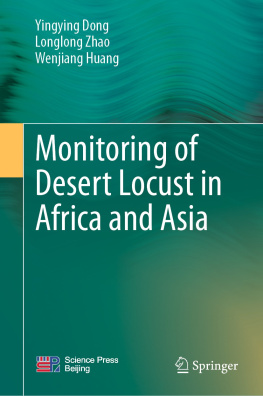"The 17-Year Locust"
U.S. DEPARTMENT OF AGRICULTURE Leaflet No. 310
THE PERIODICAL CICADA
No other insect in North America excites as much curiosity and wonder as does the periodical cicada when it makes its sudden, springtime appearance at intervals of 17 or 13 years.
After years of living in underground tunnels, millions of cicadas issue from the earth as if by a predetermined signal, undergo startling transformations, and spread through nearby trees and bushes. From morning till night they fill the air with their weird, droning song. In a few weeks, after mating and laying eggs, they die.
The periodical cicada, often erroneously called the 17-year locust, is widely distributed over the eastern half of the United States, and occurs nowhere else in the world. In the North its life cycle is completed in 17 years; in the South the cycle is completed in 13 years.
The adult insect is about 1 inches long. Most of its body is black. The legs are reddish, some of the veins in the nearly transparent wings are orange, and the eyes are red.
The periodical cicada, known scientifically as Magicicada septendecim, is closely related to common cicadas, which appear every year. The common cicadas, called harvest flies and dog-day cicadas, appear later in the season than the periodical, and the adults live longer. Their whirring song, which is slightly similar to that of the periodical cicadas, but has less variation in the notes, is a "lazy" sound that we associate with the languorous days of late summer.
Cicadas have a beak for piercing plant tissue and drawing sap into their bodies. They are large relatives of leafhoppers, aphids, scales, and other sucking insects.
Some Misconceptions
The dramatic and bizarre elements in the life cycle of the periodical cicada have caused the insect to be regarded, not only with curiosity, but also with superstition and fear.
Even before the white man came to North America, the Indians thought its periodic appearance had an evil significance.
Early American colonists had never seen the periodical cicada. They were familiar with the Biblical story of locust plagues in Egypt, but were not sure what kind of insect the story referred to. When the cicadas appeared suddenly by the millions, some of the colonists thought a "locust plague" had been visited upon them.
To some extent the confusion between cicadas and locusts exists today; cicadas are commonly called locusts. The term "locust" is correctly applied only to certain species of grasshoppers. Migratory locusts, which comprise one of these species, ruined crops in Egypt in Biblical times. They still damage crops in that country and in many other parts of the world.
Even when the periodical cicada is not confused with some other insect, its appearance in overwhelming numbers arouses fear that crops will be destroyed. But the cicada does not feed on foliage of any kind. If the adults feed at all, they do so by inserting their beaks in bark and sucking juice. Although the adults cause no feeding damage, the adult females make injurious punctures in twigs and limbs of trees and bushes with their egg-laying apparatus.
A false belief that is much less widely held today than formerly is that the distinct black W toward the outer end of the front wings foretells war. The mark is a characteristic of the species, and is produced by deeper pigmentation of the veins.
The cicada cannot sting, and any story is mythical that tells of cicadas poisoning fruit by stinging it.
How Cicadas Develop
Using the blades of a curved, sawlike egg-laying apparatus on the end of the abdomen, the female cicada punctures the bark of a twig and makes a pocket in the wood. In the pocket she lays 24 to 28 eggs in 2 rows. She then moves forward, cuts another pocket, and lays more eggs. She continues this process until 5 to 20 pockets have been made in the twig. The pockets are placed close together in a straight row. Sometimes they form a continuous slit 2 or 3 inches long. Moving from one twig to another, a cicada lays a total of 400 to 600 eggs.
Section through egg punctures showing rows of eggs About 5 times natural size.
The eggs are laid in twigs and small branches of a wide variety of trees and plants. They hatch in 6 to 7 weeks. The immature insects are called nymphs.
The newly hatched nymphs fall to the ground and burrow until they find suitable roots, from which they suck juice. This is the beginning of a 17- or 13-year period of underground existence. Most of the nymphs are 18 to 24 inches beneath the surface.
Nymph ready for
transformation. | Adult beginning to
issue from nymphal skin. |
Adult nearly free
from nymphal skin. | Freshly transformed
adult. |
By spring of the 17th or 13th year the nymphs are fully grown. The transformation to the adult stage of the life cycle is soon to occur. Several weeks before emerging from the ground, the nymphs start burrowing upward. When they have burrowed to about an inch beneath the surface, they stop and await the proper time to continue.
When the proper night comes, in April or May, the nymphs leave the ground in vast numbers and head for upright objects. A tree is the ideal goal if it can be attained. But the transformation from nymph to adult cannot be delayed. If a tree is not within range, a bush or a weed, a blade of grass, or even a post or a telegraph pole, will do. The nymph secures a good hold on the object, splits its nymphal skin along the middle of the back, and laboriously works itself out. The job of shedding the nymphal skin is completed in an hour or less. The cicada is now an adult, but is soft and white. It hardens and becomes darker. In a few hours it is fully mature.
The insects mate within a week after becoming adults. A few days after mating, the females lay eggs.
The adults live 5 or 6 weeks.
Not all cicadas pass through all the stages of development. Many eggs do not hatch. Some nymphs never get established on roots, and some die while trying to shed their nymphal skins.
When They Appear
Latitude and elevation produce the conditions that determine the date on which cicadas come out of the ground. In some southern areas the period of emergence begins in the last week of April. In some northern areas it begins in the last week of May. Between these early and late extremes, periods of emergence occur elsewhere. The farther north the cicadas are, the later they emerge.
The fact that periodical cicadas in the North have a 17-year life cycle, and those in the South a 13-year cycle, should not be interpreted to mean that the insect is seen only at 17-year intervals in the North and only at 13-year intervals in the South. The insects emerge somewhere almost every year. The explanation is that there are different broods, which emerge in different years.
Adult several hours after transformation.
Cicadas of the 17-year race that emerge in any given year comprise a brood, those that emerge the next year comprise another brood, and so on. The same is true of the 13-year race.
While adults of one brood are singing in the trees, other broods, in different stages of development, are in the soilperhaps close by, perhaps hundreds of miles away. They will emerge when they have passed their allotted time in the soil.










